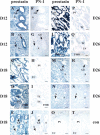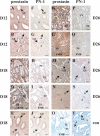Expression of prostasin and protease nexin-1 in rhesus monkey (Macaca mulatta) endometrium and placenta during early pregnancy
- PMID: 16801525
- PMCID: PMC3957810
- DOI: 10.1369/jhc.6A7005.2006
Expression of prostasin and protease nexin-1 in rhesus monkey (Macaca mulatta) endometrium and placenta during early pregnancy
Abstract
Serine proteases have been documented to play key roles in uterine matrix turnover and trophoblastic invasion during implantation. Roles of prostasin serine protease in these processes, however, are currently unclear. The present study was first conducted to investigate the colocalization of prostasin and its cognate serpin, protease nexin-1 (PN-1), in rhesus monkey endometrium and placenta on days 12, 18, and 26 of pregnancy by using in situ hybridization (ISH) and immunohistochemistry. With ISH, expression of prostasin mRNA was intensely localized in the glandular epithelium on days 12 and 18 and in the placental villi, trophoblastic column, trophoblastic shell, and fetal-maternal border on days 18 and 26. With the progress of pregnancy, expression level in the glandular epithelium was significantly decreased, and the accumulation in the placental compartments was further increased. In addition, the stroma and arterioles exhibited modest levels of prostasin signals. However, expression level of PN-1 in these compartments on adjacent sections in the three stages of early pregnancy was weak or below the level of detection. Prostasin protein expression in the endometrium was found to be consistent with the distribution patterns revealed in the ISH experiments. It may be suggested from these results that prostasin is involved in endometrial epithelial morphology establishment, tissue remodeling, and trophoblastic invasion during early pregnancy. The cognate serpin PN-1 was not coordinately expressed along with prostasin, creating a tissue environment favorable for proteolytic activities of prostasin during early pregnancy events.
Figures


References
-
- Andreasen D, Vuagniaux G, Fowler-Jaeger N, Hummler E, Rossier BC. (2006) Activation of epithelial sodium channels by mouse channel activating proteases (mCAP) expressed in Xenopus oocytes requires catalytic activity of mCAP3 and mCAP2 but not mCAP1. J Am Soc Nephrol 17:968–976 - PubMed
-
- Bhagwandin VJ, Hau LW, Mallen-St Clair J, Wolters PJ, Caughey GH. (2003) Structure and activity of human pancreasin, a novel tryptic serine peptidase expressed primarily by the pancreas. J Biol Chem 278:3363–3371 - PubMed
-
- Carson DD, Bagchi I, Dey SK, Enders AC, Fazleabas AT, Lessey BA, Yoshinaga K. (2000) Embryo implantation. Dev Biol 223:217–237 - PubMed
-
- Chen LM, Chai KX. (2002) Prostasin serine protease inhibits breast cancer invasiveness and is transcriptionally regulated by promoter DNA methylation. Int J Cancer 97:323–329 - PubMed
-
- Chen LM, Hodge GB, Guarda LA, Welch JL, Greenberg NM, Chai KX. (2001a) Down-regulation of prostasin serine protease: a potential invasion suppressor in prostate cancer. Prostate 48:93–103 - PubMed
Publication types
MeSH terms
Substances
Grants and funding
LinkOut - more resources
Full Text Sources
Miscellaneous

